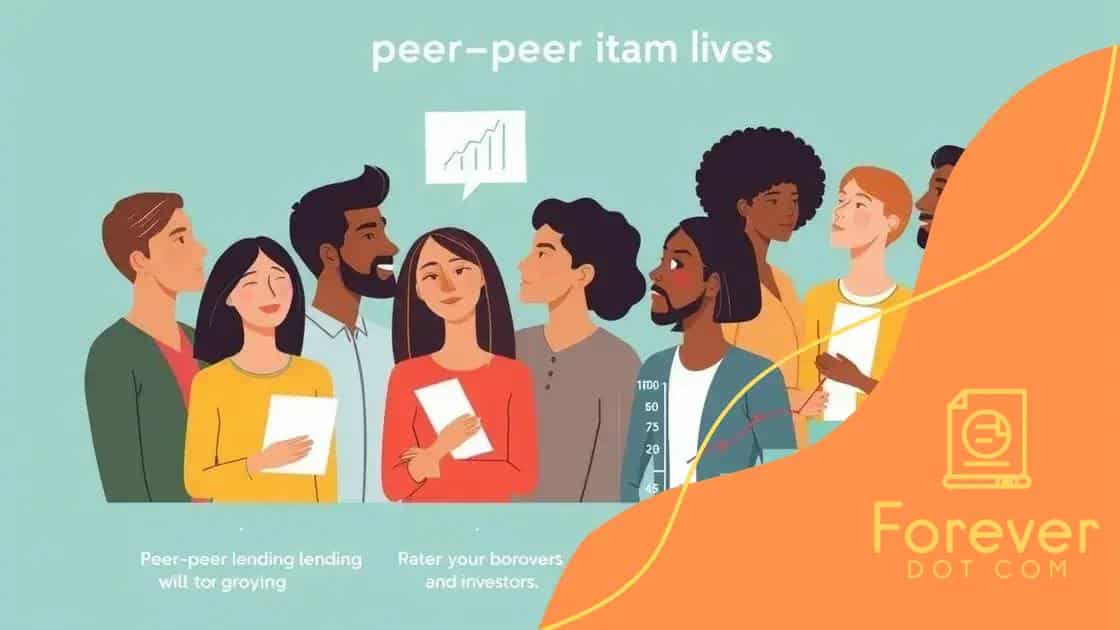Peer-to-peer lending platforms and their financial impact

Peer-to-peer lending platforms connect individual borrowers and lenders directly, offering benefits such as lower interest rates for borrowers and higher returns for investors, while also presenting risks like loan defaults and limited regulation.
Peer-to-peer lending platforms are changing the way we think about borrowing and investing. These platforms connect individual lenders directly with borrowers, offering alternatives that traditional banks may not provide. Curious about how they work and what impact they have on our finances?
Understanding peer-to-peer lending
Understanding peer-to-peer lending is essential for both borrowers and investors. This modern method of lending departs from traditional banks, allowing individuals to lend and borrow money directly. But how exactly does it function?
How Peer-to-Peer Lending Works
Peer-to-peer lending involves online platforms that connect borrowers with potential lenders. These platforms vet applicants and assess their creditworthiness, determining who can borrow and at what rate. Generally, the process includes:
- Application by the borrower through the platform.
- Approval and listing of the loan.
- Investors choosing to fund portions of loans.
- Repayment terms, where borrowers pay back the loan with interest.
This system enhances accessibility to funds, especially for those who may be turned down by banks. It also allows lenders to earn returns on their investments, diversifying their portfolios.
Benefits of Peer-to-Peer Lending
There are several advantages to consider with peer-to-peer lending. One key benefit for borrowers is typically lower interest rates compared to conventional banks. Additionally, the approval process can be much faster, which is incredibly useful for urgent financial needs.
- Greater flexibility in loan amounts and terms.
- Access to funding for people with less-than-perfect credit scores.
- Potential for higher returns for investors than traditional savings.
Moreover, the transparent nature of these platforms allows users to see exactly where their money is going and the risks involved. Overall, peer-to-peer lending is reshaping the financial landscape, making it easier for everyday people to engage in lending.
In summary, understanding peer-to-peer lending clarifies its impact on the finance industry. It offers innovative opportunities for both borrowers and investors that traditional banks cannot always match.
How peer-to-peer platforms work
How peer-to-peer platforms work is a crucial topic for understanding the lending landscape. These platforms serve as intermediaries, matching borrowers with individual lenders. They simplify the borrowing process and create opportunities that traditional banks often overlook.
The Process of Peer-to-Peer Lending
When a borrower needs a loan, they apply through a peer-to-peer lending platform. The platform will assess the borrower’s creditworthiness, which is crucial in determining loan eligibility. Here’s a quick overview of the key steps involved:
- Borrower submits a loan request outlining their needs and financial situation.
- Platform evaluates the application using credit checks and income verification.
- If approved, the loan is listed on the platform, visible to potential lenders.
- Lenders can review loan requests and choose to fund all or part of the loan.
This system not only benefits borrowers by providing access to funds but also allows investors to earn interest on their loans. The resulting transactions are often quicker than those conducted in traditional financial institutions.
What Happens After Funding?
Once a loan is fully funded, the borrower receives the money and agrees to a repayment schedule. Payments typically include both principal and interest, and they are made directly through the platform. This creates a smooth experience for both parties involved.
Each platform has its own rules, so it’s smart to compare options before committing. Some platforms offer greater flexibility in payment terms, while others might have higher fees. Overall, understanding how peer-to-peer platforms work reveals the ease and efficiency they bring to the lending process.
Benefits of using peer-to-peer lending

The benefits of using peer-to-peer lending are significant for both borrowers and investors. This alternative financing method introduces fresh possibilities that traditional banks often overlook. With its unique approach, peer-to-peer lending opens doors for many who seek flexible financial solutions.
Advantages for Borrowers
For borrowers, one of the primary benefits is the ability to access funds at lower interest rates compared to those typically offered by banks. Additionally, the approval process tends to be faster and less complicated, which is crucial for urgent financial needs. Some of the other advantages include:
- More lenient credit score requirements, allowing individuals with lower scores to qualify.
- Flexible loan terms, enabling borrowers to choose what works best for them.
- Quick access to cash without the lengthy bureaucracy of traditional banks.
These factors make peer-to-peer lending an attractive option for many people.
Benefits for Investors
Investors also find appealing opportunities in peer-to-peer lending. By lending money to individuals or small businesses, they can earn competitive interest rates. This not only helps diversify their investment portfolio but also contributes to the growth of communities by supporting local borrowers. Some reasons to consider investing in this space include:
- Higher potential returns compared to traditional savings accounts.
- The chance to directly help borrowers achieve their goals.
- Transparency regarding where their money is going, making informed decisions easier.
Overall, the benefits of using peer-to-peer lending create a win-win situation for both parties involved. Borrowers gain access to essential funds quickly, while investors can enjoy profitable returns while making a difference.
Risks associated with peer-to-peer lending
While there are many benefits, it is also important to understand the risks associated with peer-to-peer lending. Every investment comes with risks, and peer-to-peer lending is no exception. By being aware of these risks, both borrowers and investors can make informed decisions.
Default Risk
The biggest concern for lenders is the potential for borrowers to default on their loans. Unlike banks, peer-to-peer platforms often extend credit to individuals with varying credit scores. This can increase the likelihood of loan defaults, which can directly affect investors’ returns. Therefore, it’s crucial for lenders to evaluate the creditworthiness of borrowers before investing.
Limited Regulation
Peer-to-peer lending operates in a less regulated environment compared to traditional financial institutions. This can lead to issues such as:
- Fewer protections for investors and borrowers.
- Inconsistent lending practices across platforms.
- Potential for fraud or misuse of funds.
Investors should thoroughly research the platforms they choose to use to ensure a level of trust and credibility.
Market Volatility
The financial market can be unpredictable. Economic downturns can affect borrowers’ ability to repay loans, increasing default risks during difficult times. While peer-to-peer lending can provide better returns in stable markets, it can also expose investors to higher risks when the economy shifts.
Understanding the risks associated with peer-to-peer lending allows both borrowers and investors to approach this financing method with caution. By being informed, individuals can mitigate these risks and optimize their experiences in the peer-to-peer lending landscape.
The future of peer-to-peer lending
The future of peer-to-peer lending is bright and filled with possibilities. As technology continues to evolve, so does the way people borrow and lend money. This financial model has gained traction, and many believe it will further transform the lending landscape.
Technological Advancements
With ongoing advancements in technology, peer-to-peer lending platforms are becoming more efficient. Automation helps streamline processes, making it easier for borrowers to apply and for lenders to assess risks. For example, artificial intelligence is being used to analyze credit profiles more accurately, leading to better decisions. Here are some technological trends impacting this space:
- Enhanced data analytics for improved risk assessment.
- Blockchain technology to ensure transparency and security.
- Mobile applications that allow instant transactions and easy access to funds.
These innovations promise a more user-friendly experience for everyone involved.
Regulatory Changes
As the popularity of peer-to-peer lending grows, so does the attention from regulators. Governments may introduce new regulations to protect consumers and ensure fair practices. The future might see changes like:
- More stringent credit reporting standards.
- Improved investor protections and disclosures.
- Increased oversight for lending platforms to prevent fraud.
While regulations can create challenges, they can also build trust in the system, encouraging more participants.
Market Expansion
Currently, peer-to-peer lending is a dominant force in consumer lending; however, it is also expanding into other areas like small business financing and real estate investments. This diversification could offer attractive returns for investors and more options for borrowers.
Overall, the future of peer-to-peer lending looks promising, with new technologies, potential regulatory advancements, and market expansions making it an exciting field to watch. As it evolves, both borrowers and lenders can benefit from the flexibility and opportunities that these platforms provide.
FAQ – Frequently Asked Questions about Peer-to-Peer Lending
What is peer-to-peer lending?
Peer-to-peer lending is a method where individuals can borrow and lend money directly to each other without going through banks.
What are the main benefits of peer-to-peer lending?
The main benefits include lower interest rates for borrowers and higher potential returns for investors, along with a more streamlined lending process.
What risks should I be aware of?
Risks include potential loan defaults, limited regulation, and economic factors affecting repayment ability.
How do I choose a peer-to-peer lending platform?
Research different platforms, check their fees, read user reviews, and ensure they have good security measures in place.






